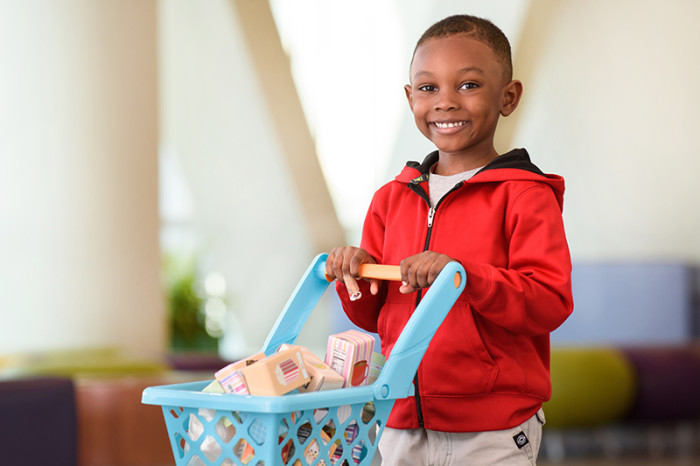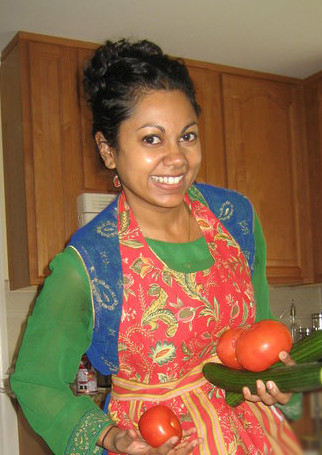Children's Emergency Department is now located in Children's Tower: 1001 E. Marshall Street.
Learn more
Having a happy and healthy shopping trip to the grocery store might seem tough when kids are coming along! With a little advance planning, you can make sure your kitchen is stocked with ingredients that match the budget, time, health needs and preferences for your family. Thinking about what you can do before, during and after the grocery trip can be a helpful approach, according to Healthy Lifestyle Center dietitian Sonya Islam.

Plan your meals for at least one week (longer if your trips to the grocery store are less frequent). Think about your household schedule. Will everyone in the house be at home every night for meals? Are there special considerations this week like field trips, evening activities or potlucks? Plan your meals and make a list according to this plan. Always build in some flexibility for when things don’t go as planned – for example, you may want to stash a few bags of vegetables in the freezer for days when you have less time to prepare meals than expected.
Involve your children in the meal planning process! Present kids with a few healthy meal options and see if they have any reactions or different ideas to offer. Incorporate what they particularly enjoy in the healthy meals you plan. For example, they may really like Asian flavors and crunchy textures – so you may want to make Asian-style chicken salad with lots of crisp vegetables and a homemade sesame dressing. Also, consider how to involve your children in the meal preparation. For example, small children can tear up greens for salads or shake up a homemade salad dressing in a jar, while older children can season, cook and plate healthy dishes. Any involvement in the cooking process can encourage kids to be more open-minded about eating (or at least trying!) nutritious meals.
Check flyers for items on sale to stay on track with a budget – what’s featured might inspire you with meal ideas too! Aim to buy ingredients that are not loaded with excess fat, sugar or salt.
Check the pantry. See if there are any ingredients for the meals you are planning already in your home, or things you need to use up!
Make a list. A useful tip is to organize your list according to aisles of the grocery store. This can help you avoid running back and forth too much. Look over your list and consider what will need to be used up soon (salad greens, for example), and what can stay preserved for longer or get put in the freezer for future use. If there are too many things to use up all at once, you may want to rethink your meal planning.
Ask for your child’s input before going to the store. In addition to asking children about meal ideas, see they have any requests for snacks, etc. It can be easier to negotiate and come to decisions about these items before heading to the aisles! Simple things like picking up a favorite flavor of yogurt or a vegetable that your child is curious to try can make it more likely that they will eat these healthy choices once you bring them home.
Take items for distraction if needed. The grocery store is designed to grab attention! Items that you might NOT want to bring home, like sugary cereal, are often placed at eye level for little ones. Books or a small toy can help to distract children from these temptations.
Take reusable bags and, if needed, cooler bags. Sturdy bags that can transport your groceries safely are a great idea. Kids can be in charge of gathering bags when you are ready to go when you keep them in a regular place!
Make sure you and your kids are not hungry! Going to the store when you are hungry can make you more susceptible to temptations. (And these impulse buys can often be high in fat, sugar and/or salt!)
During the grocery store trip
Map out your plan for efficiency. It can be easy to get bored or tired when being in a place for too long. Use your list to guide you through the store in a focused way.
Stick with the list. It’s important to be consistently firm about what is on the list – if not, kids may be more likely to get upset if they don’t get what they spontaneously ask for. While being firm, you can acknowledge any frustration a child expresses with responsive, supportive statements like: “It can be tough when we don’t get what we want,” and then reminding them of desirable things on the list that are being purchased. If they persist in asking for the same thing over and over again, use the “broken record method”- repeat a statement like “We made our decisions about what’s on the list. That is what we are buying.”
Think about activities that keep kids occupied. In addition to their book or toy, games can children engage children with their surroundings in a focused way. Activities like I Spy or counting items of a certain color in the aisle can be a fun way to keep them occupied. Older kids can be in charge of checking off items from a grocery list, or reading nutrition facts labels to find healthy options (things like lower-sugar cereals, higher-protein yogurt, etc.).

Make healthy choices easy choices by making foods that you are encouraging your child to choose as attractive as grocery stores make them!
- Wash and pre-cut sturdy vegetables and fruits that won’t discolor and pack into individual snack bags, grab-and-go containers or “recipe kits” for the meals you planned.
- Put washed whole fruits in a bowl to make them easy to pick up and eat.
- Pre-slice part-skim or 2 percent cheese or portion nuts into individual, protein-packed servings. You can also buy pre-portioned versions (like string cheese or 100-calorie nut packs) but they are sometimes more expensive.
- Make single-serve bags of homemade trail mixes without too many sugary ingredients added. ItMaking your own can be a better alternative to prepacked trail mixes or granola bars, which can be loaded with sugar and/or fat. Healthy ingredients to include are: unsweetened or lightly sweetened whole grain cereal, small portions of nuts, and freeze-dried fruits that are naturally crisp, sweet and low in calories without added sugar. For example, you can fill a snack-size bag with ½ cup whole grain cereal, 1-2 tablespoons of your favorite toasted nuts, and 1-2 tablespoons of freeze-dried fruits (like strawberries or pineapple). Press the air out as you seal up the bags so they stay fresh and ready to go!
- Place these great healthy options in easy reach so they are ready whenever your kids are!
Notice a change in your labels? Check out Sonya’s blog post about the FDA’s new requirements for the Nutrition Facts panel and how these changes can help you make healthy choices for your family.
Looking for something new (and healthy!) for your kids to try? Sonya’s recipe for a Fun & Fruity Banana Split is a fun option for a protein-packed breakfast or meal!
We can help! TEENS+ is a healthy lifestyle intervention for overweight teens (ages 12-16) and their parents. Learn more, view FAQs, and see if you and your teen qualify for this no-cost program.